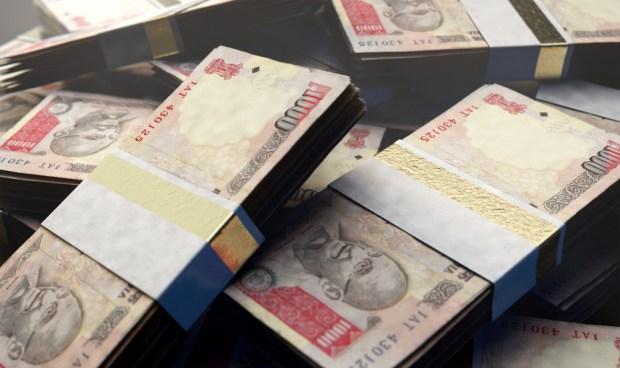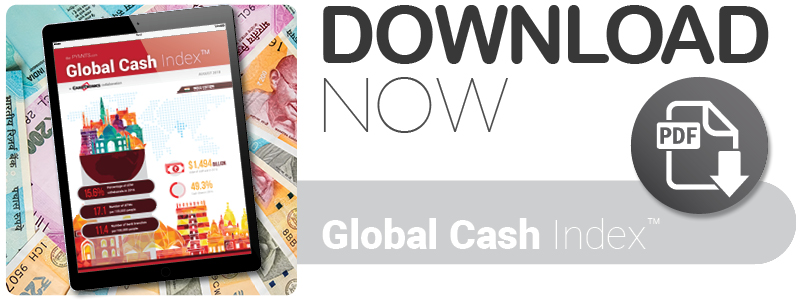Cash Remains Central To India’s Economy, But Competition Is Growing

Two years in, India is seemingly undergoing “remonetization,” with cash usage growing 10.5 percent and returning to pre-demonetization levels. In fact, use of cash is expected to reach $2.45 trillion by 2021, up from $1.5 trillion in 2016. That said, the policy has helped digital payments advance by three to four years, says YES BANK’s Chief Digital Officer Ritesh Pai. He recently told PYMNTS how alternate payment methods are competing with cash in India. Plus, find over 350 data points on what’s helping cash flourish, in the latest Global Cash Report.
Despite its government’s efforts to shift from physical bank notes to digital payment systems, cash continues to thrive in India.
The country’s demonetization policy was launched to help boost tax revenues, spur the modernization of its payment system, crack down on corruption and deter its underworld economy. Residents’ decades of cash use and a sizable rural population that falls outside the traditional banking infrastructure makes demonetization a highly challenging goal, however.
The cashless experiment has not yet rendered cash obsolete in the country, either. It has opened new opportunities for alternative payment options like mobile wallets to gain ground, however — an important move in a country with a sizable, mobile-savvy, young population.
PYMNTS recently caught up with Ritesh Pai, chief digital officer of India’s YES BANK, about the country’s high affinity for cash, the shift in consumers’ payment preferences and the long digital payments road ahead.
Electronic Payments Gain Appeal
Prior to the demonetization implementation, Pai noted that India was heavily cash dependent. Approximately 95 percent of all transactions were made using cash as recently as 2016, and 90 percent of merchants did not have an electronic POS system to accept card-based payments.
The Indian population has not abandoned cash en masse since demonetization, though. In fact, the Reserve Bank of India (RBI) recently reported that cash in circulation as a share of GDP will likely return to its pre-demonetization levels.
While the policy might not have resulted in a rapid overnight shift to digital payment systems, Pai explained that it did have another impact: Specifically, it prompted many Indian citizens to explore and discover alternative payments.
“Demonetization got the ball rolling,” Pai explained. “[Fearing] the absence of cash, people had no choice but to go to electronic payments.”
The policy has ultimately helped to fuel India’s digital banking system. Without it, adoption of more modern, electronic payment methods may have proceeded at a considerably slower pace.
“What it ended up doing is it gave [us] a jump of about three to four years,” Pai said. “Otherwise, to do it in a more organic way would have taken much more time.”
Helping to Inform Consumer Choice
Demonetization may have breathed life into the digital payment market, but not all consumers are ready to give up cash in favor of a debit or credit card or mobile wallet options like the UPI or PayPal. Some prefer using cash, others an alternate payment form, meaning there’s no “one-size-fits-all” approach, Pai said. Consumers have varying payment needs, too, and banks and retailers need to account for that.
“As a bank, I often take the view that we have to behave like a restaurant, where you have a buffet spread,” he added. “You have all the cuisine that is available, and the customers pick and choose what they want.”
YES BANK works to pitch new consumers on the potential benefits of digital banking, but it also takes steps not to alienate cash-focused customers in the process.
“If you try to force [alternative] solutions down [the] throats of people who are still interested in cash, then sometimes you will have pushback,” Pai said.
There are many small- to medium-sized Indian businesses (SMBs) interested in transitioning from cash to an electronic payment option. They might have relationships with suppliers and customers who primarily rely on cash, however, therefore slowing or preventing the switch.
The Long Road Away from Cash
India is also home to a sizable rural population, a group that often falls into the “underbanked” category, according to Pai. Digital banking infrastructure often doesn’t extend to its geographic area, meaning this population’s very scope could keep cash in play for a long time to come.
“It’s a real Herculean task [for banks] to cater to these locations,” he said.
The country’s rural residents are also less trusting of the electronic payment system, and news of hacks and data breaches can further erode their already low confidence in digital banking. This keeps the group returning to cash.
“In the eagerness to move to electronic payments, you cannot compromise the safety and security aspect,” Pai said. “[That’s] because you will have a lot of vulnerable people in the ecosystem who will get cheated. Once they lose faith in this payment system, it’s very difficult to get back.”
Residents in these areas are often slower to adopt newer payment methods like mobile wallets, unlike those in more populated metro regions. Biometric solutions could go a long way toward assuring rural citizens that their data is secure, though, and Indian banks are currently raising awareness about how iris scans or fingerprints can authenticate electronic payments using the Aadhaar system.
In fact, the Indian government’s demonetization has created an opportunity for FIs like YES BANK to educate rural and urban residents alike about the growing field of payment options, Pai said. It has ultimately failed to reduce the influence of cash, however, which is likely to remain active in the economy for years — even as new payment methods gain popularity.
“For cash to be eliminated completely will be a challenge,” he added.
All told, the policy has begun a conversation about India’s current payments and what we can expect to see down the road. New methods are gaining ground and showing promise, but cash still has a reliable seat at the payments table for the foreseeable future.

